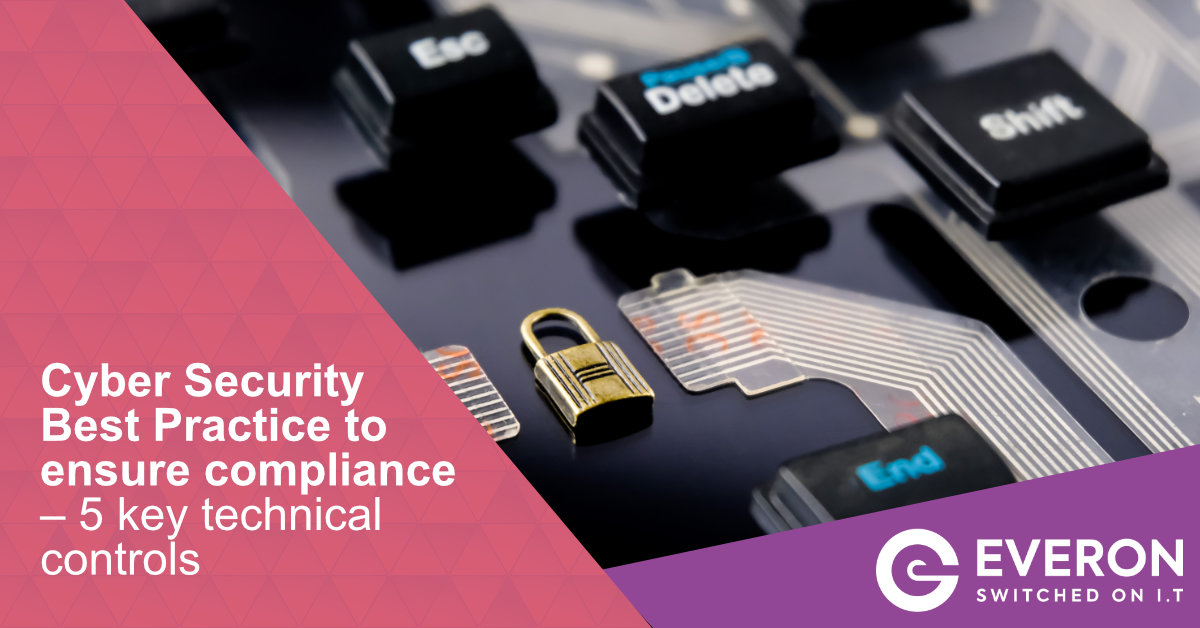Data security and integrity is a complex, multifaceted challenge, requiring the application of a wide range of measures both technical and organisational. We’ve looked at some of the organisational structures that can be used to underpin your compliance obligations, but how do you go about implementing the technical controls required? Where do you start in deploying the myriad technical devices and which protections should you prioritise?
The National Cyber Security Centre’s ‘Cyber Essentials’ scheme sets out 5 key technical controls designed to offer a good standard of protection against all but the most advanced cyber attacks. Working in harmony with the organisational measures we’ve talked about, these controls will guard your infrastructure against the majority of threats and give you the tools to enforce information security policies in accordance with your compliance obligations.
These 5 key baseline controls include:
Firewalls
Firewalls are security devices which moderate traffic entering and exiting a network based on a set of pre-defined rules. Useful for restricting access to dark, malware-infested corners of the web, Firewalls can be configured to limit access solely to trusted sites and services.
Firewalls can be set up at the edge of your office’s local area network to moderate web activity in your office in a way that reduces risk and exposure to cyber criminality. They can also be used at device level, and can be fundamental in securing remote devices using rules which restrict access to work-relevant sites and web resources.
Configure for maximum security
Whenever you acquire a new device or a new software product it will likely be configured for maximum accessibility, with restrictive security features deactivated by default. Additionally, new hardware often comes with pre-installed applications which often go unused and abandoned, presenting an enlarged attack surface for cyber criminals.
Use an initial security audit as an opportunity to reconfigure new technology for maximum security. Start by identifying and deleting unwanted applications as these will do nothing but occupy storage space and present entry routes for hackers. Change default passwords to more secure alternatives or consider multi factor authentication wherever this is an option.
Enforce strict access controls
For cyber criminals, user accounts affording widespread data access and administrative privileges are the most sought after. These present the fewest “roadblocks’ to criminal activity, allowing unrestricted lateral system-wide access to sensitive information and the ability to lock out legitimate users by reconfiguring settings. Security best practice dictates that admin privileges should be extended to as few users as possible, and such privileges should be exercised using dedicated, feature-limited user accounts to further mitigate risk.
More generally, user access to resources, systems and devices should be granted strictly on an as-needed basis to limit security risk. And sensitive information types should be subject to more stringent access safeguards.
Deploy anti-malware measures
“Malware” means “malicious software”, and is used to refer to the various software-based tools cyber criminals use to infiltrate networks, extort financial reward from victims, corrupt files and steal data. Some of the most common and well-known malware types include: viruses, ransomware, keyloggers and worms.
Anti-malware solutions are a vital component of any cyber defence toolkit. Endpoint devices should be protected by anti-virus software designed to identify and remove malicious code that ends up on your system, and consider using email filtering to detect and block malicious email attachments from finding their way into your inbox. For more advanced protection XDR (extended protection and response) platforms can scan your entire IT environment for malicious intrusion and take preventative action before disaster strikes.
Create a “whitelist” of trustworthy, approved applications and audit hardware to ensure that no software that isn’t on this list is installed on your network. Lastly, reduce the malware threat posed by removable media by disabling “autorun” across all your devices.
Keep software and systems maintained
Ensure software vulnerabilities are rectified quickly by applying software “patches” and updates in a timely manner. You should also discontinue the use of software and hardware which are no longer supported, as without regular manufacturer updates such systems will quickly become a serious security vulnerability in your IT estate.
Commercially-savvy I.T, the Everon way
Here at Everon our multi-sector experience makes us uniquely aware of the varying commercial pressures organisations face. The current economic climate has amplified these pressures, making it more vital than ever that your business’s technology aids your commercial goals and doesn’t constitute a financial burden.
Get in touch to learn more, and we can set your business on the path to higher profit margins and financial resilience, through the strategic deployment of technology.

